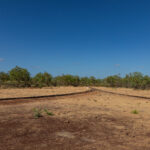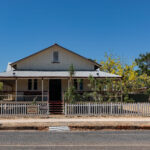Wednesday, 16 October 2024
We were up early this morning as we needed to be back in Normanton to catch The Gulflander at 8.30am. Although it was well past dawn there were still quite a few wallabies about but fortunately none silly enough to jump out in front of us. As we drove back to Normanton this morning, we noticed another weird type of tree that looked dead with no foliage at all but lots of green fruit or seed pods on it. No idea what it could be.
Of course, we padded the amount of time we would need to drive back to Normanton and arrived half an hour before our scheduled departure. Much better to be early though rather than miss our train. Everyone was loaded up before 8.30am but we had to sit in the station with the diesel engine idling until EXACTLY 8.30am. The driver told us that he is not allowed to leave the station early.
At 8.30am precisely we pulled out and made our way slowly through Normanton. The train line intersects with quite a few local roads, so the horn had to be sounded as we approached each crossing. Our driver, Garry, was a bit worried at one level crossing with a driver speeding along the road beside the railway line and then doing a right-hand turn towards the line. She did stop but Garry was pretty worried that she was not going to.
So, our rail journey today on the Gulflander is a quirky little ride that is said to be ‘from nowhere to nowhere’. In the late 1880s the plan was to build a rail line to bring copper from Cloncurry to Normanton to be shipped from the river port on the Norman River. However, when gold was discovered in Croydon the plan to connect Normanton with Cloncurry changed. When the gold ran out in Croydon the line remained without it ever being connected to the state’s rail network, hence the ride from nowhere to nowhere.
The first service from Normanton railway station in 1891, was hauled by the ‘Norman’ A10 class steam locomotive. Since 1929, railmotors have operated on the line, providing a faster and more cost-effective alternative to the former steam locomotive. The railmotors were built on bus or truck chassis converted for rail use.
Garry gave us A LOT of information about the rolling stock that they operate on the line. It all got a bit confusing because one is currently out of commission, but they hope to have it back in service for their next season. Despite all the technical railway speak going over my head Bernie assures me that today we rode the RMD93, affectionate known as the ‘Tin Hare’. This railmotor was built at the Ipswich Railway Workshops in 1950. It arrived in Normanton in 1982 and was painted with its ‘Gulflander’ name in 1987. The engine is a 102 horsepower Gardner diesel engine with a 4-speed crash gearbox. I am just copying this information out of the Trip Guide; I have no idea what it all means!
We trundled along the line with Garry providing commentary and pointing out highlights of the journey. We traversed the ironstone ridge that Normanton sits upon before descending onto the Norman River flood plain. We stopped at a flood marker that showed the water levels reached in several big floods. The biggest was in 1974 when a certain cyclone devastated Darwin and caused severe flooding across the Gulf Savannah that resulted in the evacuation of Normanton and Karumba.
We motored past waterholes that are almost completely dry as the end of the dry season approaches then crossed the Norman River between Glenore and Critters Camp. At the 32 Mile mark David deposited mail at the Haydon mail stop. Several stations collect their mail from this box. We continued through East Haydon before stopping at Blackbull at the 56-Mile mark for morning tea.
After our tea break there were only six passengers (and three staff!) left on the train. The remainder of the passengers were part of a tour group, and their coach met them at Blackbull so that they could be at Cobbold Gorge by tonight. We chugged on through Timber Cutters, Ellavale and Golden Gate before pulling into Croydon, 94-Miles from Normanton. Along the way we saw a variety of birds, agile wallabies and cattle. And learnt that those dead looking trees we saw this morning are kapok trees and they always look dead at this time of the year. When the wet season starts their leaves will come back and they will produce stunning yellow flowers.
Alighting at Croydon we were pleasantly surprised to be met by Croydon’s Tourism Officer, Sonya, with the air-conditioned council bus. After sitting in a pool of sweat on an uncomfortable vinyl seat for the last five hours this was very welcome. After a quick tour around the small town of Croydon pointing out the heritage precinct Sonya dropped us off at Reese Park opposite the Club Hotel.
We grabbed some sandwiches from the Croydon Café and Supermarket. Despite the stifling heat we walked back to the heritage precinct buildings that Sonya had pointed out to us. The buildings are open for visitors, so we were able to pop into the Shire Hall and the Court House before viewing the old police station with its cells out the back and the police residence. Next, we stopped into the AIR-CONDITIONED Tru Blue Visitor Information Centre. Bernie and Steve went to look at the old steam locomotives in the garden while Cathy and I opted to watch the short film about Croydon’s history in air-conditioned comfort!
After the film, we walked through Anzac Park to photograph Croydon’s artwork piece on the Savannah Art Trail. It turns out the statue – Dancing Brolgas – we have been photographing at sunset the last two nights in Karumba is their contribution to the art trail. Croydon’s piece is titled Returning Boomerang … and it was so much smaller than it appeared to be in our Matilda Country Magazine. Some photography trick, I suppose?
Our next stop was at the Club Hotel. At the height of the gold rush Croydon had over 30 hotels. The Club Hotel is the last one standing. We spent a bit more cash in Croydon purchasing some cold drinks at the bar while waiting for our bus ride back to Normanton.
At 3.15pm we headed over to Reese Park to wait for the Trans North bus service that would return us to the Railway Station in Normanton. The bus runs from Cairns to Karumba every second day which makes it possible to return to Normanton on the same day. The Gulflander runs from Normanton to Croydon on Wednesdays then returns to Normanton on Thursdays. Not that you would want to ride back on the train! Five hours one way was quite enough heritage train journey for us all.
The bus arrived just a few minutes late and there was plenty of room for six more passengers. The bus driver, Brownie, greeted us with so you’re all waiting for the bus to Sydney?? Ha, ha. The bus journey was blissfully air-conditioned and so much quicker and smoother than the train. It took us five hours to travel to Croydon and only an hour and three quarters to return!
Tonight, we are staying at the rather crusty Albion Hotel in Normanton. The standard of accommodation is a far cry from what we enjoyed the last two nights in Karumba. Unfortunately, there’s not much to choose from in this neck of the woods! After unpacking the car we popped back out to the Foodworks for some fruit for tomorrow morning’s breakfast and then did a quick drive around to Normanton’s attractions: Kris the BIG croc, the BIG barramundi, the Purple Pub and the Normanton Lily sculpture. The sculpture depicts the Carpentaria Lily and magpie geese that are important endemic species.





























